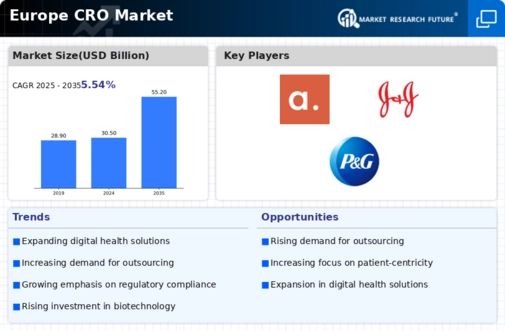Europe Cro Size
Europe CRO Market Growth Projections and Opportunities
The renal dialysis market has been steadily growing due to several important reasons. One of the main drivers is the increasing number of people with chronic kidney disease (CKD). Chronic kidney disease is becoming more common due to factors such as diabetes, hypertension, and an aging population. For example, the Centres for Disease Control and Prevention (US) predicts that by 2023, 35.5 million US adults, or 14% (more than 1 in 7), will have CKD. Similarly, a review article published in 2022 stated that chronic kidney disease affects over 10% of the global population, which is more than 800 million people. The growing awareness about CKD and the availability of better diagnostic tools have also helped in the early detection and diagnosis of the disease, leading to timely interventions like renal dialysis. Advances in dialysis machines, filters, and patient monitoring systems have also improved the overall treatment experience and outcomes.
In addition to the increasing prevalence of CKD, the expanding elderly population, along with higher healthcare spending and favorable reimbursement policies, have made renal dialysis services more accessible to a larger part of the population. Ongoing research and development efforts have resulted in the introduction of innovative dialysis methods and therapies, further fueling market growth. Furthermore, dialysis service providers have expanded their operations into emerging markets, making dialysis services more available in underserved regions.
The growth of the renal dialysis market has created an environment where essential treatments for patients with CKD and end-stage renal disease are more widely available. The expansion of dialysis services into underserved regions has helped in providing vital treatments to those who previously had limited access. This has positively impacted the market's expansion, ensuring that more individuals receive the necessary care and support for their kidney-related health issues. Impact of Technological Advancements on Renal Dialysis Moreover, advancements in technology have played a crucial role in improving the effectiveness and accessibility of renal dialysis treatments. Innovations in dialysis machines, filters, and patient monitoring systems have enhanced the overall patient experience and treatment outcomes. These technological advancements have contributed to a more efficient and comfortable dialysis process, ultimately benefiting the patients undergoing treatment.
In conclusion, the renal dialysis market has experienced significant growth due to the increasing prevalence of chronic kidney disease, advancements in technology, expanding elderly population, and efforts to make dialysis services more accessible. This growth has created an environment where essential treatments for individuals with CKD and end-stage renal disease are more widely available, positively impacting the lives of many. As the market continues to evolve, it is expected to play a crucial role in meeting the growing demand for renal dialysis treatments and supporting the well-being of individuals with kidney-related health issues.








Leave a Comment